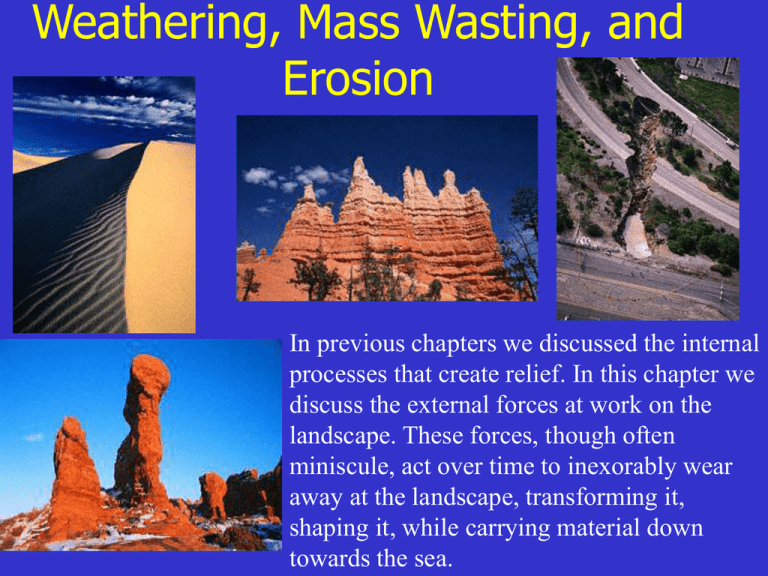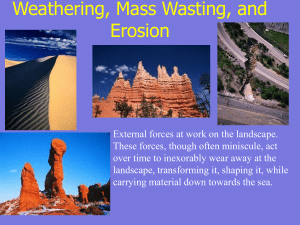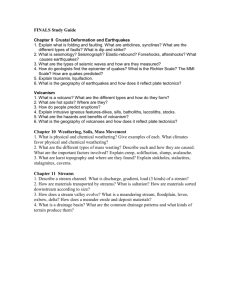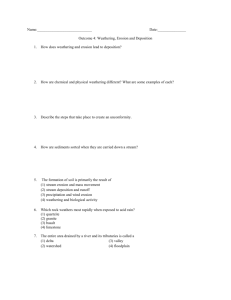Weathering, Mass Wasting, and Erosion
advertisement

Weathering, Mass Wasting, and Erosion In previous chapters we discussed the internal processes that create relief. In this chapter we discuss the external forces at work on the landscape. These forces, though often miniscule, act over time to inexorably wear away at the landscape, transforming it, shaping it, while carrying material down towards the sea. Weathering > Mass Wasting > Erosion > Transport > Deposition Weathering The mechanical disintegration and/or chemical decomposition that fragments rock masses into smaller components. The processes begin in: Microscopic spaces Joints Faults Lava Vesicles Difference between a joint and fault: • Faults show relative displacement. • Joints are more common. Types of Weathering Mechanical (Physical) - no change in chemical composition. – Frost wedging – Salt wedging Chemical - decomposition of rock through a chemical change in its minerals. Oxidation - important in iron-rich rocks Hydrolysis - igneous rocks have much silica which readily combines with water Carbonation - carbon dioxide dissolved in water reacts with carbonate rocks to create a soluble product (calcium bicarbonate) Types of Weathering Biological - plants and animals contribute to weathering. – Roots physically break or wedge rock – Lichens (algae and fungi living as single unit), remove minerals and weaken rock by releasing acids – Burrowing animals can increase weathering. Lichens Frost Wedging in joints Frost Wedging and Sheeting San Jacinto Mtns. Frost Wedging in Joshua Tree National Park, CA Relationships between climate and weathering Mass Wasting Process whereby weathered material is moved downslope under the immediate influence of gravity. Angle of Repose - the steepest angle that can be assumed by loose fragments on a slope without downslope movement. Talus or scree slope - pieces of rock at bottom of a rock fall. Angle of Repose Dependent upon the internal coherence of the material. Softer, looser material has lower angle of repose. Rock and compressed sediments can have very high angles of respose. Rockfall Pacific Palisades, November 1956 Pacific Palisades Slide, 1956 Monterey Park Debris Flow, 1980 La Conchita Landslide, January 10, 1995 • Triggered by powerful winter storms. • Killed 10 people; destroyed 18 homes. • Previous landslide in 1995 destroyed 9 homes but killed no one. The rock slide at Frank, Alberta, Canada (1903) moved 33 million cubic meters of rock from Turtle Mountain over the town of Frank in less than two minutes killing 70 people. Yosemite Rockfall, 1996 78,000 cubic yards of granite fall from Glacier Point, destroying Happy Valley Nature Center and killing one. • • • • • Erosional Agents and Deposition Running Water Stream Landscapes Glaciers Waves and Currents Wind Waterholes Canyon, Navajo Nation Zion National Park, Utah The Fluvial Processes • Sheet flow - on smooth, non-permeable surfaces: roads, concrete, bedrock. This is rare. • Stream flow - Stream Flow as water finds path of least resistance stream flow begins. – Gully erosion on dirt road in mountains. How to preserve the road? Crown the road or let water flow underneath where it wants to go. Drainage Basins (Watersheds) They form nested hierarchies. Divides Drainage Basins (Watersheds) Stream Load 1 Whenever water is in motion, it carries some load. 2 The amount of load carried by a stream is positively related to its volume and velocity. 3 The maximum size of stream load is dependent upon velocity and volume of stream flow. 4 Thus, when a stream slows, it deposits load and when it increases its speed it erodes material to add to its load. Stream Load Bedload: Saltation - series of small jumps Traction - dragging along the bottom. Stream Profile Stream Grading • Degrading - material is eroded from the landscape by fast moving water. Stream incises the landscape. • Aggrading - material is deposited by slow moving water. Depositional features predominate. • Graded - neither process dominates. Streams tend towards this equilibrium over time. Stream Grading • • • • Headwaters Higher Elevation Steeper Gradients V-Shaped Degrading (Erosive) Valleys • Graded or Aggrading • Small or no gradient • Meanders • Wide Valleys • Floodplains Deltas broad triangular shape, such as Nile River (Greek letter) outlets become clogged and new channel created maze of outlets richest habitat severely threatened by diversions and pollution Sac. / San Joaquin delta Colorado River delta Nile River Delta, Egypt Mahakam River Delta and Silt Plumes, Borneo, Indonesia Stream Meanders Develop on very level floodplains. San Joaquin River Meander Bends: Erosion and Deposition Outside of Bend Is Eroded Inside of Bend Has Deposition (Point Bar) Bedrock Alluvium Formation of Natural Levees Headward Erosion This is the basis of rill, gully, and valley formation. Juncture between sheet and stream flow shows speed, and hence erosive, increase. Headward Erosion / Waterfalls Niagra Falls, Canada Angel Falls, Venezuela, 3212 ft. Drainage Patterns Dendritic - most common, all meet at < 90o Rectangular - highly jointed bedrock Trellised - alternating strata of differing density Parallel - unconsolidated material Entrenched Meanders • Meanders generally suggest flat floodplains. However, in a number of places in the world they have been incised deeply into the landscape. • How might this have happened? Is this river aggrading or degrading? Is it near the headwaters or the delta? Is this river aggrading or degrading? Is it near the headwaters or the delta? Aggrading, at the delta Is this river aggrading or degrading? Is it near the headwaters or the delta? Is this river aggrading or degrading? Is it near the headwaters or the delta? Graded, near the middle or end of its course. Missouri River, MO Is this stream aggrading or degrading? Is it near the headwaters or the delta? Is this stream aggrading or degrading? Is it near the headwaters or the delta? DEGRADING, NEAR THE HEADWATERS Canadian Rockies






